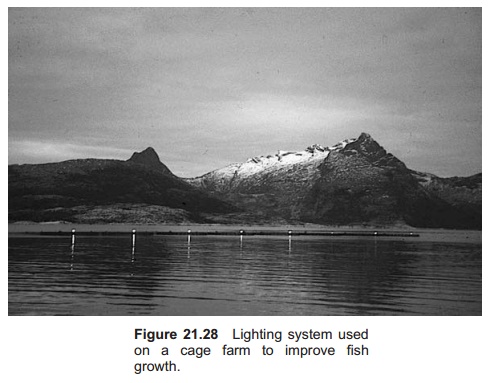Chapter: Aquaculture Engineering : Design and Construction of Aquaculture Facilities
The cages and the fixed equipment
The cages and the fixed equipment
Cages and net bags
The number, type and size of the cages depends on the production regime and the farmed species. The exposure of the site to waves is also important. If the site is very exposed, special offshore cages are used. Large cages have become increasingly popular because the production costs can be reduced. In the Norwegian salmon industry, circular
However, extra demands are made on the equipment used for handling the nets. Another trend is to utilize more exposed water for farming, which sets extra requirements for the cages, mooring systems and operating boats.


Sea cage farms may also be established close to the shore, so that a walkway can be constructed from the land directly to the cages (Fig. 21.27). In such conditions it is normal to use a system farm, or at least a farm with a floating walkway, to where the cages are moored.
A dead fish collector may be used in the cage: this can either be in the form of a stocking below the ordinary net bag, or a basket inside the cage. The basket can easily be lifted to the surface with a rope, and the dead fish collected.
Lighting system
To increase the growth and reduce early maturation, additional and continuous lights can be used in the sea cages.4,5 In particular, during the winter season in high latitudes, this has been shown to improve the production results for salmoinds by 20–30%.6 Thus in almost every sea cage in Norway extra light is used to increase growth and reduce maturation. The light source can stay above or beneath the surface. When having the light above the water surface it must be quite strong because it has to go through the water surface (Fig. 21.28). Light above the surface may be detrimental to the surroundings; for instance, there have been com-plaints from ships. For example, on a cage 15 m × 15 m four 500 W floodlights have been used; the necessary brightness is around 180 lux, the same as recommended for rooms not in continuous use, such as storerooms.

When planning a light installation, the following factors are important:
1. Type of light source
2. Placement of light source above or beneath the surface
3. Number of lights
4. When in the year it shall be used
5. For how large a part of the day it shall be used
6. Source of energy
7. How to get the energy to the cage; where shall electrical cables be laid or shall generators be used?
Today, underwater lights have become much more commonly used, because they are closer to what is to be illuminated. Also, they do not cause the problems associated with non-submerged lights, e.g. navigational confusion.
Feeding system
Several methods are used for feeding fish in cages, ranging from hand feeding where no additional equipment is required to automatic feeding where the additional installations depend on the chosen feeders. If traditional feeders are used, they are placed on a platform that could be integrated in the collar. The hoppers can be quite large (>1 m3) and additional buoyancy is necessary. If central feeding systems are used it is only the pipes with the feed that enter the cages and no additional equipment is necessary. It can be possible to use additional equipment inside the cage such as detectors for uneaten feed and biomass estimation. Such equipment will, however, be portable
Related Topics